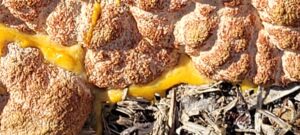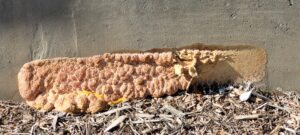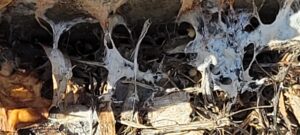Understanding Dog Vomit Mold: A Guide to the Unpleasant but Harmless Slime
Introduction
Dog vomit mold, scientifically known as Fuligo septica, is a type of slime mold that often appears in gardens and yards, especially after periods of wet weather. Despite its unappealing name and appearance, dog vomit mold is relatively harmless and can be managed with simple steps. This article will delve into what dog vomit mold is, its causes, and how to deal with it effectively.
What is Dog Vomit Mold?
Dog vomit mold is not actually a mold or fungus, but a slime mold belonging to the protist kingdom. It is more closely related to amoebas than fungi[1]. This organism thrives on decaying organic matter, making mulch, rotting logs, and leaf litter prime locations for its growth[2]. The mold gets its name from its appearance, which resembles a pile of vomit, often yellow or orange in color, though it can also be gray or black[1].
Causes of Dog Vomit Mold
The primary cause of dog vomit mold is the presence of decaying organic material combined with moisture. The spores of Fuligo septica are spread by wind and can survive in dry conditions for years, waiting for the right environment to grow[2]. When conditions are warm and moist, such as after heavy rain, these spores absorb moisture, crack open, and release the slime mold[2].
Scientific Details
Taxonomy and Classification
Fuligo septica belongs to the domain Eukaryota, phylum Amoebozoa, class Myxogastria, order Physarales, and family Physaraceae[1]. It was first described by French botanist Jean Marchant in 1727 and later classified by Carl Linnaeus in 1763[1]. The species was transferred to the genus Fuligo by German botanist Friedrich Heinrich Wiggers in 1780[1].
Life Cycle
The life cycle of Fuligo septica includes several stages:
- Spore Stage: The mold begins as tiny spores, which are spread by wind and can remain dormant for years[2].
- Plasmodium Stage: When conditions are favorable (warm and moist), the spores hatch into microscopic single cells that join together to form a plasmodium, a multinucleate mass of undifferentiated cells[1]. This stage allows the mold to move in an amoeboid-like fashion, searching for nutrients[2].
- Fruiting Stage: The plasmodium eventually transforms into a sponge-like aethalium, which is analogous to the spore-bearing fruiting body of a mushroom[1]. The aethalium then degrades, darkening in color, and releases its dark-colored spores[1].
Resistance to Metal Toxicity
Fuligo septica has a remarkable resistance to toxic levels of metals, particularly zinc[1]. The mold produces a yellow pigment called fuligorubin A, which chelates metals and converts them to inactive forms[1]. This unique adaptation allows the mold to thrive in environments with high metal concentrations.
Is Dog Vomit Mold Harmful?
One of the most common concerns about dog vomit mold is whether it poses any danger to humans, pets, or plants. Fortunately, dog vomit mold is harmless. It does not produce toxins and is not known to cause any diseases[1][2]. While it might look unsightly, it is actually beneficial to the environment as it helps decompose organic material, turning it into nutrients that enrich the soil[2].
How to Manage Dog Vomit Mold
Managing dog vomit mold is relatively straightforward. Here are some steps you can take to control and remove it from your yard:
1. Rake Over the Mold
Raking over the affected area can help break up the mold and expose it to air, which dries it out and stops its growth[1]. This simple action can significantly reduce the presence of slime mold in your garden.
2. Adjust Irrigation
Since dog vomit mold thrives in moist conditions, reducing the amount of water in the area can help prevent its growth[1]. If you have an irrigation system, consider adjusting it to reduce the frequency of watering.
3. Hose Off Large Patches
For larger patches of slime mold, using a hose to wash it off can be effective[1]. This method helps remove the mold from plants and mulch without harming the environment.
Preventing Dog Vomit Mold
Preventing dog vomit mold involves maintaining a dry environment and reducing the amount of decaying organic material in your yard. Here are some preventive measures:
1. Regular Maintenance
Regularly raking and turning over mulch can help keep it dry and less hospitable to slime mold[1]. Removing fallen leaves and other organic debris can also reduce the chances of mold growth.
2. Proper Mulching
Using high-quality mulch that decomposes slowly can help prevent the rapid buildup of decaying material[2]. Avoid using mulch that retains too much moisture, as this can create ideal conditions for slime mold.
3. Improve Drainage
Improving the drainage in your garden can help reduce moisture levels[2]. This can be achieved by adding organic matter to the soil to improve its structure and drainage capabilities.
Conclusion
Dog vomit mold may be an unpleasant sight in your garden, but it is harmless and easy to manage. By understanding its causes and taking simple steps to control and prevent it, you can keep your yard looking clean and healthy. Remember, while it might look alarming, dog vomit mold is just another part of the natural decomposition process, helping to recycle nutrients back into the soil.
For more information, you can Google “dog vomit mold” to learn more about this fascinating organism.
Feel free to adjust or add any additional information to better suit your blog’s style and audience! If you need further assistance, just let me know.
[1]: Fuligo septica – Wikipedia [2]: Dog Vomit Slime Mold: The Mysterious Blob That Isn’t What You Think!
Frictionless Property Management

California Property Managers.
Connect with the premier property management team.
Looking for a full list of management services?
Looking for residential management?
Price is important, so here’s everything you need to know.
Fill out the form below and we will send you a price & proposal guide for our services.
Download the price guide and proposal.







